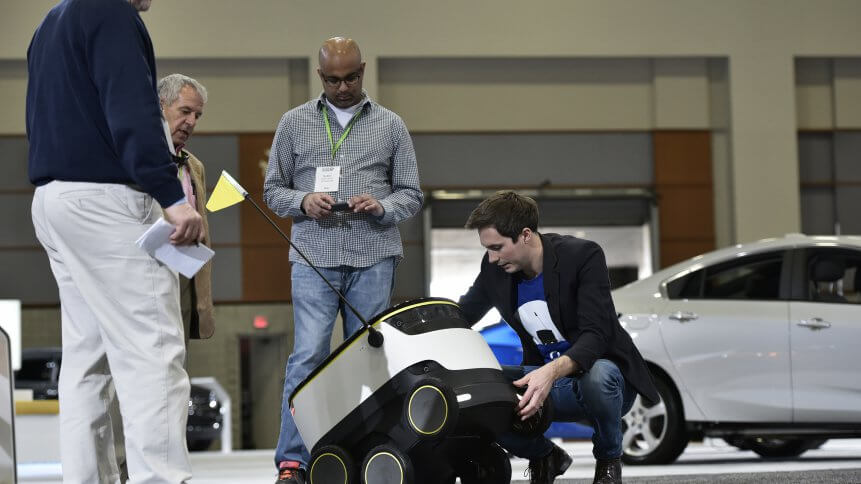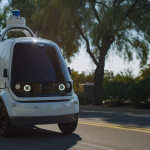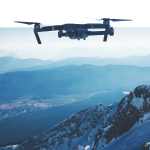Are last mile delivery technologies taking off?

The last mile delivery space is seeing a huge amount of activity right now.
As shoppers become increasingly demanding when it comes to online delivery options, increasingly innovative solutions and initiatives are emerging rapidly with the goal of satisfying consumers’ on-demand expectations.
Disrupting the last mile delivery market could not only give companies a competitive edge, but it could also dramatically cut costs. For Amazon, annual delivery costs exceeded US$27 billion in 2018.
With the stakes for optimization high and ‘traditional’ delivery methods not up to the task, players are increasingly turning to emerging technologies.
Robot deliveries
Tesco is working with Starship Technologies on a robot/food delivery initiative in Milton Keynes. The retailer is fulfilling the service from a Tesco Extra in the city’s Kingston Centre.
Using Starship’s app, customers can order groceries for delivery in as little as 15 minutes within a two-mile radius of the store. They pay usual shelf prices for products and £1 for the service.
Last month, meanwhile, Starship launched at George Mason University’s Fairfax, VA campus, in conjunction with Sodexo.
Its 40,000 students, faculty and staff can access the Starship Deliveries app to order food and drinks to be delivered anywhere on campus. Blaze Pizza, Starbucks, and Dunkin’ are the first retailers to participate, with more to be announced in the coming weeks. Each delivery costs US$1.99.
Autonomous vehicles
Walmart has teamed with Udelv to test its autonomous delivery vans in Surprise, Arizona. Udelv will utilise a cargo van custom-made to deliver fresh groceries – hand-picked by Walmart’s personal shoppers – to customers.
Tom Ward, Senior Vice President, Digital Operations, Walmart US, said that the retailer was still learning, but wants to make sure it stays on the cutting edge of grocery delivery by exploring what’s new and next.
Softbank’s Vision Fund, meanwhile, has invested US$940 million into startup Nuro, at a valuation of around US$2.7 billion.
The US-based company has been testing out its tech with Kroger since last year. It will use SoftBank’s money to build its fleet, expand its service and work with new partners.
Unattended in-home delivery
A number of retailers are trying out unattended in-home delivery services. Waitrose, for instance, has been testing demand for its ‘While You’re Away’ offering with 100 customers located within the delivery area of its dotcom fulfillment center in Coulsdon, south London.
Using Yale smart lock technology, the customer grants access to a delivery driver by setting a temporary access code for the lock which is then sent to Waitrose via an app. The code is then sent to the driver’s device at the time the customer has booked for the delivery and is deleted once the delivery is complete.
YOU MIGHT LIKE

Is your business ready for driverless deliveries?
The driver will put refrigerated and frozen goods away and leave other groceries on the kitchen counter, or as instructed by the customer. The whole delivery is captured on a chest-cam worn by the driver, with the video available for request for the customer the next working day.
If the pilot is a success, Waitrose will look to make the service available to more than 1,000 customers in spring 2019.
Delivery by drone
Iceland’s largest e-commerce ventures, Aha, is upping the number of drones it utilizes across the country’s capital, Reykjavik, after launching a trial with Flytrex in 2017.
Wing, a startup that is part of Alphabet, has announced a drone delivery pilot in Helsinki, Finland, beginning in the spring.
It kicked things off in 2014 in rural Queensland, Australia where it transported a first-aid kit, candy bars, dog treats, and water to farmers. Then in September 2016, it sent burritos to students at Virginia Tech in what was, at the time, the largest and longest drone delivery test on US soil.
Most recently, it has completed hundreds of deliveries to the yards of several homes in the Australian Capital Territory and Queanbeyan regions of Australia.
Bad news for Click & Collect?
All of this last mile delivery innovation is set to have an impact on the UK Click & Collect market. This is set to rise 45.8% over the next five years, hitting £9.8 billion (US$ 12.8 billion) by 2023, according to GlobalData. Growth, however, will slow.
The growing number of retailers closing stores and implementing CVAs will reduce the availability of collection points, increasing usage of alternative options. Additionally, many customers are opting for home delivery as express deliveries are included in the vast majority of schemes.








